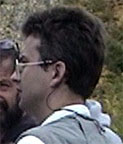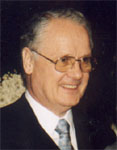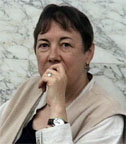

The following scientists will participate in the Program (all lectures are given in English):
Dr. Mann is the organizer of the course. He
is Professor of Anthropology at Princeton University, and a Research Associate
in the Laboratoire d'Anthropologie of the Université de Bordeaux. He
has worked on the South African australopithecines and most recently has focussed
on the Neandertals of Europe.
Dr. Mann provides the cement that keeps the course together. He will give several
introductory lectures that provide background to the study of modern human origins,
and will introduce the lectures of each of the speakers. He reviews and places
in the overall context of the course each of the guest speaker lectures. Dr.
Mann is at every lecture and on the field trips. He is the person to contact
about the course and its various components.
Dr. Bruno Maureille
 Dr. Maureille is the
co-ordinator for the course. He is a researcher at the Laboratoire d'Anthropologie
of the Université de Bordeaux. Dr. Maureille has done research on ancient
and modern human populations in many parts of the world. Bruno has worked in
the United States and has done research at the University of Pennsylvania Museum.
He is the Director of the Archaeological Investigations at the paleolithic site
of Les Pradelles, in the village of Marillac, where our field work will take
place. Bruno will direct our work at the site during the last several weeks
of the course. While we are at the university in Bordeaux, Bruno will act as
our intermediary with the Laboratoire and will deal with other aspects of the
course. He will be with us on our field trips to the south and to the Dordogne,
and will explain the archaeology of the sites we visit, as well as describe
the significance of the finds. He is also very knowledgeable about Bordeaux
and all of southwest France, and can provide details about bus routes, trains
connections, and the very best places to visit during your free time on the
weekends.
Dr. Maureille is the
co-ordinator for the course. He is a researcher at the Laboratoire d'Anthropologie
of the Université de Bordeaux. Dr. Maureille has done research on ancient
and modern human populations in many parts of the world. Bruno has worked in
the United States and has done research at the University of Pennsylvania Museum.
He is the Director of the Archaeological Investigations at the paleolithic site
of Les Pradelles, in the village of Marillac, where our field work will take
place. Bruno will direct our work at the site during the last several weeks
of the course. While we are at the university in Bordeaux, Bruno will act as
our intermediary with the Laboratoire and will deal with other aspects of the
course. He will be with us on our field trips to the south and to the Dordogne,
and will explain the archaeology of the sites we visit, as well as describe
the significance of the finds. He is also very knowledgeable about Bordeaux
and all of southwest France, and can provide details about bus routes, trains
connections, and the very best places to visit during your free time on the
weekends.
Professeur Bernard Vandermeersch
 Before his retirement two years ago, Professeur Vandermeersch was Professor
of Anthropology at the University of Bordeaux. Professor Vandermeersch has
been involved in some of the most important archaeological and human fossil
discoveries made over the last decades. He excavated at the cave site of Qafzeh,
in Israel, discovering a series of early modern human burials that have now
been dated to more than 90,000 years old, making them amongst the oldest modern
humans yet discovered. Later, he was part of the team that discovered the neandertal
burial at Kebara Cave, also in Israel, one of the best documented deliberate
Neandertal burials ever found. He has also been involved in the excavation and
analysis of the late Neandertal found at the site of Saint-Césaire, in
western France, a specimen now dated to the very end of Neandertal presence
in Europe, around 36,000 years ago.
Before his retirement two years ago, Professeur Vandermeersch was Professor
of Anthropology at the University of Bordeaux. Professor Vandermeersch has
been involved in some of the most important archaeological and human fossil
discoveries made over the last decades. He excavated at the cave site of Qafzeh,
in Israel, discovering a series of early modern human burials that have now
been dated to more than 90,000 years old, making them amongst the oldest modern
humans yet discovered. Later, he was part of the team that discovered the neandertal
burial at Kebara Cave, also in Israel, one of the best documented deliberate
Neandertal burials ever found. He has also been involved in the excavation and
analysis of the late Neandertal found at the site of Saint-Césaire, in
western France, a specimen now dated to the very end of Neandertal presence
in Europe, around 36,000 years ago.
Professeur Vandermeersch will deliver a lecture to the class on the "the
evolution of modern humans from the perspective of the Middle East". He
currently makes his home in Madrid.
Professeur Jean-Philippe
Rigaud
Before his retirement last year, Professor Rigaud was Directeur of the Institut
du Quaternaire of the Université de Bordeaux. He has been involved in
many archaeological excavations in the southwest of France, as well as other
parts of the world. Professeur Rigaud will visit the class for two lectures.
The first will be an appraisal of the archaeological evidence for the emergence
of Upper Paleolithic blade cultures from earlier stone tool technologies. In
his lecture, he will review the sorts of changes that have taken place and will
talk about the timing and location of this development. This lecture is given
early in the course and provides essential background to our discussions of
the dramatic appearance of these new cultures.
The second lecture given by Professor Rigaud takes
place the afternoon before our trip to the Dordogne. Professeur Rigaud, a native
of the Dordogne, has spent many years excavating in this part of France, and
in this lecture he provides a broad perspective of its geography, geology and
paleoclimatology. He reviews the major sites that we will visit, describing
the finds and placing them in the overall context of paleolithic studies.
Dr. Jean Clottes
Dr. Clottes is President of the International
Committee on Monuments and Sites. He has worked on the discovery and analysis
of Paleolithic art for more than 30 years and has visited sites in many parts
of the world. Most recently, he has been in charge of the multifaceted work
at the newly discovered cave art site of Chauvet Cave, in the southeast of France. In order to preserve its detail
as well as the fragile archaeological remains on the floor of the cave, very
few people have been able to personally visit the cave. Not only are the cave
paintings of great power, but the dates obtained from the charcoal used to draw
some images date these art works to more than 30,000 years ago, far earlier than
had been expected. Along with magnificent photos of the cave art, Dr. Clottes
brings to the class the latest information about work at the Chauvet cave as
well as his ideas about the genesis of paleolithic art.
Dr. Francesco d'Errico
Dr. d'Errico is a researcher at the institut du Quaternaire of the Universitè
de Bordeaux. He has been involved in the examination and evaluation of various
archaeological finds that have been claimed to represent the earliest appearance
of symbolic art. He brings to this investigation an array of modern technological
aids including scanning electron microscopy and computer aided reconstructions.
His talk to the class will focus on the evidence documenting the origins of
Paleolithic art.
Professor Maria-Dolores
Garralda
Professor Garralda teaches and does research at the Complutense University in Madrid (Spain). Over many years, she has investigated the fossil evidence of the very earliest modern humans in Europe, and has critically evaluated these specimens. She will review this evidence and provide an overall perspective of the initial evolutionary developments of modern appearing peoples in Europe.
Dr. Anne-Marie Tillier

Dr. Tillier is Directeur of the Laboratoire d'Anthropologie, our hosts during the early weeks of the course. She is a specialist in the study of the fossil remains of Neandertal and early modern human children. She has been able to show that even in young individuals, the distinctive anatomical features of the Neandertals are already present, distinguishing them from modern children. Dr. Tillier will describe some of her research to the class, and show how an understanding of these differences give us important insight into the nature of modern human origins. Dr. Tillier will speak to the class on the origins of deliberate burials.
Dr. Pascal Murail
Dr. Murail is a researcher at the Laboratoire d'Anthropologie specializing in the analysis of human skeletal material. He will talk to the class about how we recognize differences in the skeleton that distinguish age and sex groups. Students will have the opportunity of studying the variations in the human skeleton with a focus on those traits that distinguish living people from earlier humans.
Dr. Dominique Gambier
Dr. Gambier is a senior researcher at the
Laboratoire d'Anthropologie. She has worked extensively on the fossil remains
of early modern humans in Europe and has just published a book on the famous
early humans from the Grimaldi Caves. She will speak to us about the truly exciting
very recent discoveries at Cussac Cave and their implications for our understanding
of modern human origins.
Home | Bordeaux Highlights | Past Participants | Accomodations | Faculty | Program of Study
Archaeological Excavations | Course Description and Credit | Syllabus | Application | Contact